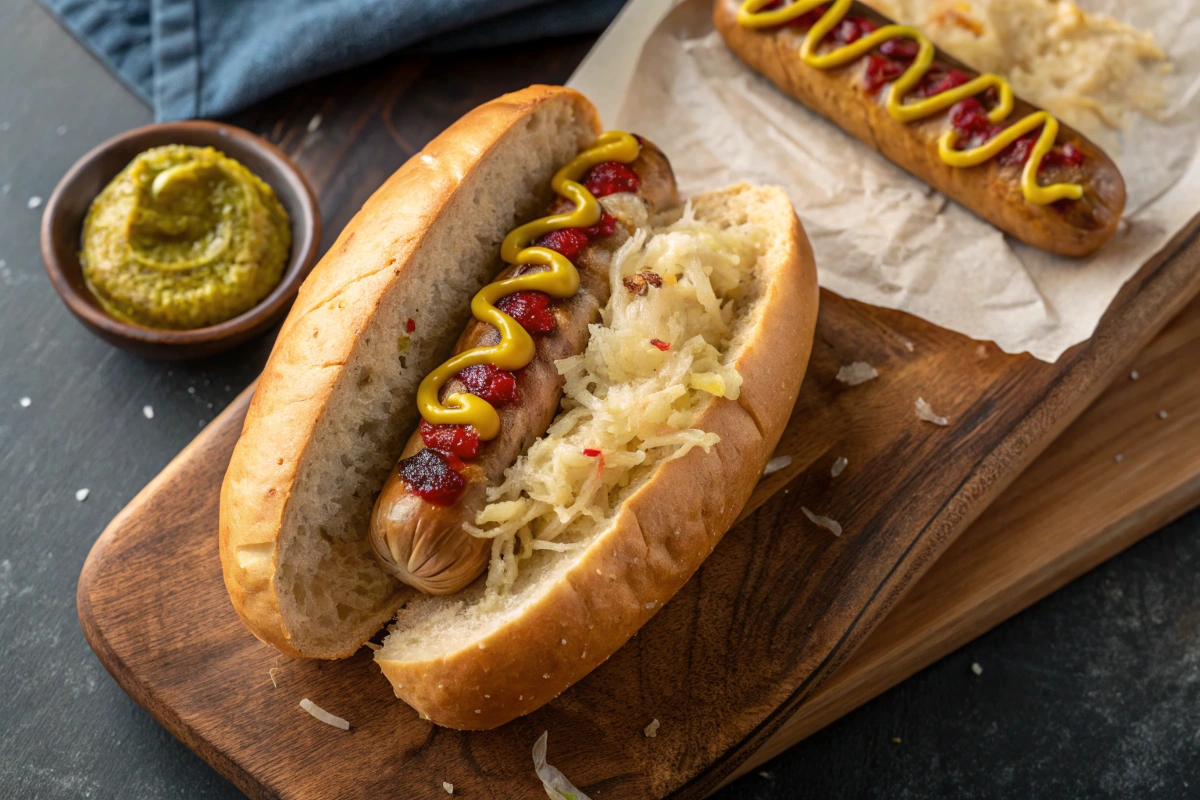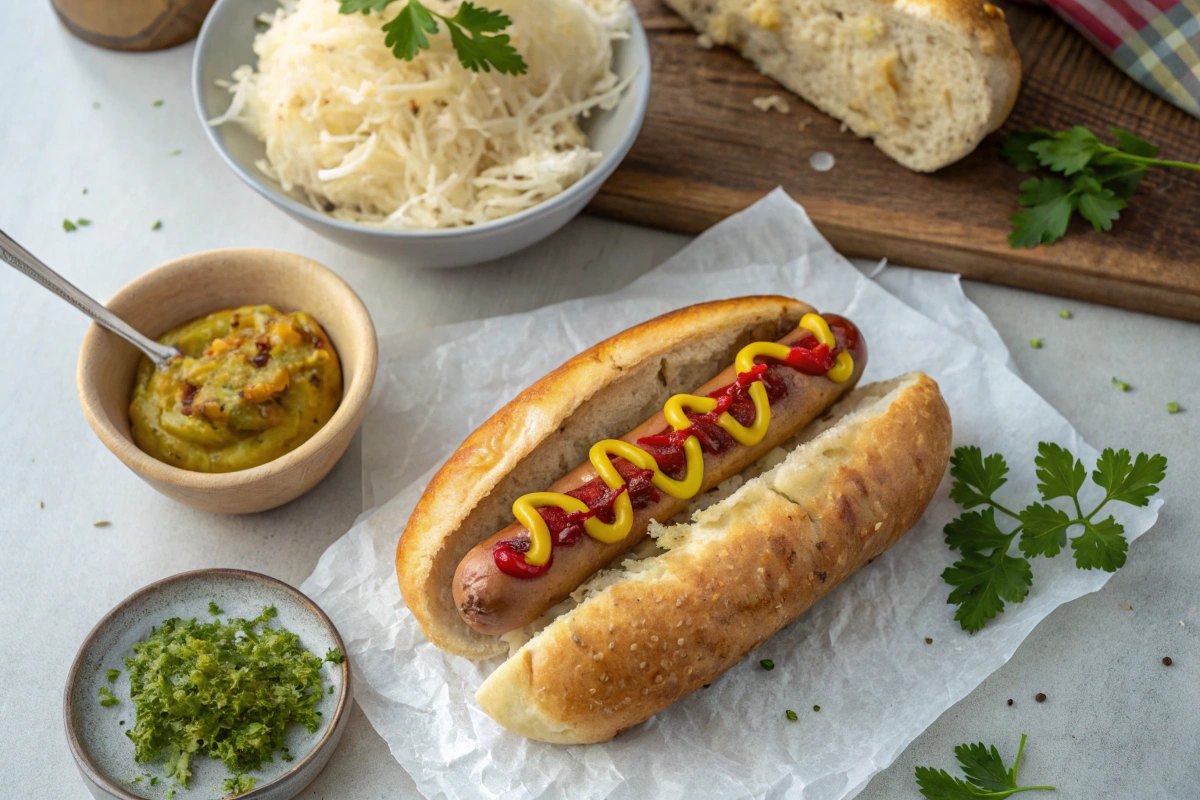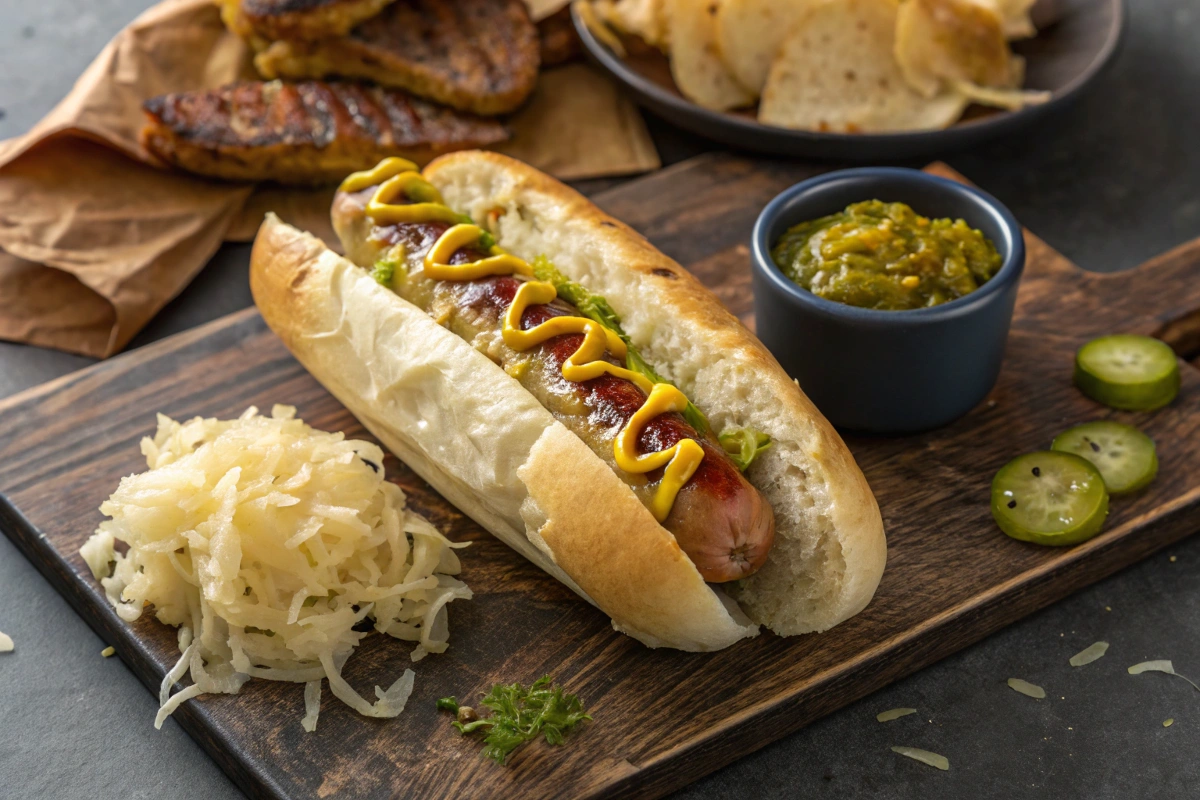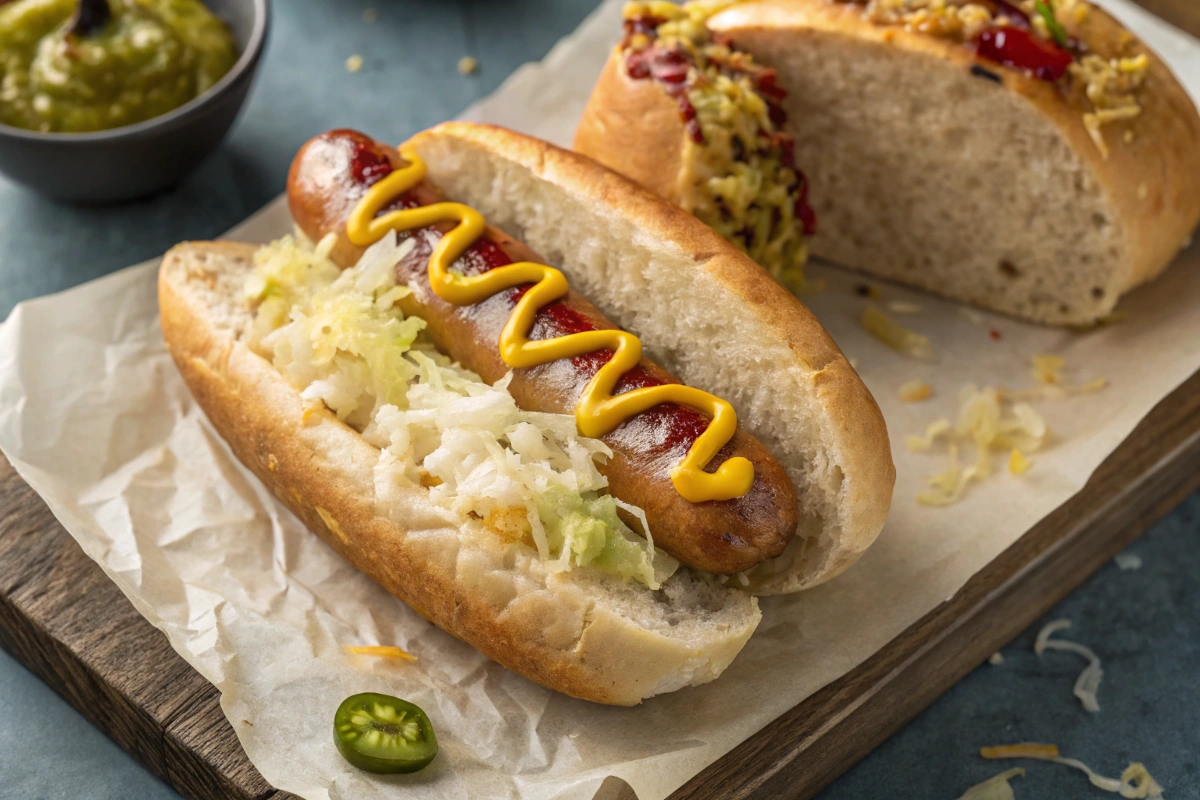What makes a brat different from a hot dog? This article explores the distinct qualities of these popular sausages. We’ll delve into their ingredients, flavors, and cultural backgrounds. You will learn the key differences between them and understand what makes each unique.
Decoding the Sausage: What Makes a Brat Different from a Hot Dog?
Sausages come in many varieties, and two favorites often appear on grills: brats and hot dogs. However, what truly sets them apart? It’s more than just a bun and some mustard. The differences lie in their ingredients, production methods, and the distinct taste experiences they deliver. Let’s explore the specifics of what makes a brat different from a hot dog.
Meat Matters: The Foundation of Flavor
The primary difference begins with the meat. Hot dogs, for example, often use a mix of beef and pork. In addition, some may include chicken or turkey. Generally, they utilize meat trimmings from other cuts. Bratwurst, in contrast, uses primarily fresh pork. Furthermore, some brats include veal for a richer flavor. Therefore, the meat composition significantly affects the final taste.
The Grind and Texture: Adding to the Difference
Specifically, the way meat is prepared is crucial. Hot dog meat is usually finely ground. Consequently, this creates a very smooth and almost uniform texture. On the other hand, brats feature a coarser grind. Moreover, this gives them a more textured and chunky feel. Thus, this difference impacts how they feel in your mouth. The texture plays a key role in the overall eating experience. For instance, the fine grind of hot dogs results in a softer, almost creamy bite. Conversely, the coarser grind of brats offers a more substantial and satisfying chew. Hence, this is a noticeable distinction for those who pay attention to the mouthfeel of their food. Additionally, some variations in processing techniques may contribute to these differences further. Therefore, the specific method used to grind the meat impacts the characteristic of each sausage.
Explore our ultimate guide to turrón for a sweet dessert option to round out your meal.
The Spice of Life: Flavor Profiles Unveiled
The spice blends used also play a vital role in what makes a brat different from a hot dog. Typically, hot dogs use a simpler blend of salt, pepper, and paprika. However, some also contain garlic powder or onion powder. Conversely, brats boast a more complex flavor profile. Indeed, they often include nutmeg, ginger, and caraway. Therefore, these spices provide a distinctive taste that’s both savory and slightly sweet. Additionally, the balance of spices in a brat is carefully considered, creating a nuanced taste. Furthermore, this complex blend is key to what makes a brat different from a hot dog. Moreover, you’ll often find regional differences in the spices used for brats, which leads to unique local variations.
Natural Casings vs. Processed: The Skin Deep Difference
The casing around the sausage impacts its texture and snap. Traditionally, brats are filled into natural hog casings. Afterward, this allows for a more natural and satisfying “snap” when you bite into it. In contrast, hot dogs often use processed cellulose casings. Therefore, this gives them a softer bite with less resistance. Specifically, natural casings are derived from animal intestines, which allows for better airflow when cooked. This also creates a distinctive texture that many sausage enthusiasts appreciate. Additionally, the snap of a natural casing provides a textural contrast to the softer interior. Thus, this textural element greatly influences what makes a brat different from a hot dog. Meanwhile, processed casings are more uniform. Consequently, this is beneficial for mass production but lacks the organic feel of natural casings.
Cooking Methods: A Tale of Two Sausages
Cooking methods can significantly influence the final taste. Hot dogs, for example, are frequently boiled or steamed. However, this is done to cook them quickly and keep them moist. On the other hand, brats are best cooked by grilling or pan-frying. Accordingly, this creates a delicious, browned exterior. Furthermore, grilling imparts a smoky flavor that elevates the overall experience. Thus, the chosen method greatly affects the final taste of each sausage. Specifically, the higher heat of grilling caramelizes the sugars in the meat. Therefore, this process develops a richer flavor profile. Conversely, boiling can leach out some flavors.
The Grill Advantage: What Makes a Brat Different from a Hot Dog on the Grill?
Additionally, grilling makes a brat different from a hot dog. The direct heat from grilling creates a crusty exterior. Conversely, hot dogs can become rubbery if overcooked on the grill. Thus, the grilling method often favors the brat’s texture and flavor. Indeed, the smoky taste enhances the savory notes in the brat. Also, the crispy casing adds another layer of texture. Moreover, this combination creates an outstanding experience. Consequently, the grill is usually the preferred method for achieving optimal results with brats.
Boiling vs. Pan-Frying: A Comparison
Chiefly, boiling, a common method for hot dogs, is less suitable for brats. Because, boiling can dilute the brat’s flavors and soften the casing. Conversely, pan-frying or grilling helps to keep the flavorful juices inside and creates that desired crisp. Therefore, these differing methods highlight what makes a brat different from a hot dog. Specifically, when pan-frying brats, using a bit of oil or butter can enhance the browning process. However, it is crucial to ensure consistent heat to achieve even cooking. Therefore, the pan-frying method is a great way to bring out the full potential of the brat. Additionally, the use of fat during pan-frying adds richness to the final product.
Cultural Roots: Where They Come From
Undoubtedly, the cultural roots of each sausage are significant. Hot dogs have strong American ties, often associated with baseball games and summer barbecues. Comparatively, bratwurst originated in Germany. Specifically, they hold a prominent place in German culinary traditions. Hence, these different backgrounds contribute to their distinct identities. Indeed, these historical roots profoundly affect how these sausages are viewed and enjoyed today. Furthermore, cultural significance plays an important part in any food tradition.
American Tradition: The Hot Dog’s Legacy
The hot dog became an American staple. Moreover, it represents a symbol of fast food culture and casual dining. Generally, it’s simple, easy to eat, and widely available. Therefore, the hot dog enjoys a broad appeal in the U.S. Additionally, hot dog carts and vendors are a familiar sight in cities across the United States. Indeed, this speaks to their enduring popularity and accessibility. Moreover, their association with iconic events, like baseball games, adds to their cultural appeal. Thus, the hot dog’s legacy is deeply rooted in American traditions.
German Heritage: The Bratwurst’s Story
On the contrary, bratwurst is a testament to German heritage. Furthermore, it’s often found at festivals and family gatherings. Indeed, many regions have their own variations of the sausage, each with unique spices and preparation methods. Thus, the brat carries a deep sense of cultural significance. Specifically, in Germany, bratwurst is often enjoyed with traditional sides like sauerkraut and German potato salad. Additionally, this association with cultural events and gatherings further cements the brat’s cultural importance. Therefore, it’s not just food; it’s a link to German heritage.
Serving Styles and Pairings
Specifically, how we serve each sausage adds another layer to the distinction. Hot dogs are commonly placed in a bun. Additionally, they are topped with ketchup, mustard, relish, or onions. Conversely, brats are often served in a roll with sauerkraut, mustard, or onions. Therefore, the traditional pairings play a key role. Indeed, these contrasting serving styles highlight what makes a brat different from a hot dog. Moreover, the toppings and condiments used enhance each sausage’s flavor profile.
Condiments and Complements: Enhancing the Flavors
For example, ketchup and mustard work well with the milder flavor of hot dogs. However, sauerkraut‘s tang perfectly complements the richness of brats. Therefore, these pairings enhance the overall eating experience. Additionally, the sweetness of relish can add a different dimension to the hot dog’s taste. Meanwhile, the use of a spicy mustard can further enhance the already rich flavor of the brat. Thus, choosing the right condiments can make all the difference in enjoying these sausages.
Buns and Bread: The Foundation of the Meal
The type of bun also contributes to what makes a brat different from a hot dog. Usually, hot dogs are served on soft, white bread buns. Moreover, brats often use crustier rolls. Hence, this difference affects the overall texture and taste of the meal. Specifically, the soft, white bun is designed to be easily consumable and complements the smooth texture of a hot dog. Conversely, a crusty roll adds a textural contrast to the juicy filling of a brat, enhancing the eating experience. Therefore, choosing the right bun is as important as selecting the right toppings.
Nutritional Differences: A Closer Look
Another important factor to consider is nutrition. Hot dogs, for instance, can be higher in fat and sodium. While, brats, though containing fat, may have fewer additives. Therefore, understanding the nutritional values is important for health-conscious consumers. Indeed, being aware of the nutritional composition of what you’re eating enables informed choices. Moreover, understanding these differences can help you plan a balanced diet.
Fat Content and Calories: Weighing the Options
Specifically, the higher fat content in some hot dogs can contribute to higher calorie counts. Comparatively, brats, which typically use leaner pork cuts, may have a different nutritional profile. Thus, this can influence your choices. Additionally, the type of fat present in each sausage can vary. Furthermore, it’s crucial to consider portion sizes when comparing calories and fat. Therefore, it’s beneficial to check labels to make an informed decision.
Additives and Preservatives: Understanding What You Eat
Usually, hot dogs are more likely to contain artificial preservatives and additives. Meanwhile, brats are often made with fewer added ingredients. Therefore, those who prefer natural foods may choose brats. Accordingly, this is an important difference to keep in mind. Specifically, the number of additives in processed meats can be a concern for those seeking natural foods. Additionally, the use of preservatives ensures longer shelf life. Therefore, opting for brats that use minimal additives can be a healthier option. However, it is always a good idea to check the label and understand the content of the foods we eat.
Exploring Regional Variations: Beyond the Basics
Furthermore, regional variations introduce another layer of complexity. Indeed, both brats and hot dogs come in different varieties. Moreover, these variations can significantly influence their taste and ingredients. Consequently, exploring these different variations can lead to new and exciting culinary experiences. Therefore, it is interesting to delve into the specific characteristic of different local traditions.
Bratwurst Variations Across Germany:
Specifically, in Germany, you’ll find variations like Nürnberger, which are smaller and spicier. Additionally, there’s Thüringer, known for its robust flavor. Furthermore, each of these local variations has its unique seasoning blend and preparation method. Therefore, exploring these variations is like taking a culinary journey across Germany. Moreover, understanding the local specialties adds depth to the bratwurst’s cultural significance.
Hot Dog Variations Across the USA:
Conversely, in the U.S., hot dogs also come in many styles. For example, the Chicago-style hot dog, which is topped with a variety of vegetables, is a local favorite. Additionally, there are hot dogs wrapped in bacon, or served with chili. Moreover, these variations showcase the flexible nature of the hot dog and its adaptability to different tastes. Thus, each region’s unique style offers an entirely different culinary adventure, making the hot dog a very versatile option.
What Makes a Brat Different From a Hot Dog: A Summary
In conclusion, several key factors differentiate brats from hot dogs. Specifically, these include the meat ingredients, spice blends, cooking methods, and cultural backgrounds. Furthermore, the serving styles and nutritional profiles also differ significantly. Therefore, both are unique and offer different culinary experiences. Indeed, these distinctions are what make each sausage special and beloved by many. Moreover, understanding the differences enhances your ability to appreciate the unique characteristics of each one.
The Key Distinctions: A Recap
To summarize, brats usually have a coarser grind, a richer spice profile and are grilled or pan-fried. Conversely, hot dogs use a finer grind, simpler spices and are often boiled or steamed. Thus, the way they are made greatly affects how they taste. Additionally, the casing, and pairing of each sausage also play a significant role in their unique identities. Furthermore, these factors contribute to a complete difference between brats and hot dogs. Therefore, appreciating their differences is key to a more enhanced culinary journey.
Making the Right Choice: Personal Preferences
Ultimately, the best choice depends on personal preferences. Some might prefer the simplicity of a hot dog, while others enjoy the rich flavor of a brat. However, understanding the differences empowers you to make the best choice for you. Consequently, both sausages can provide a delicious and satisfying meal. Indeed, personal taste plays the most important role in choosing a favorite. Moreover, it is great to experiment and discover your own preferences. Therefore, taking the time to explore all of the flavors is an important part of enjoying food.
The Best of Both Worlds: Enjoying Variety
Finally, instead of choosing a favorite, why not appreciate them both? Moreover, both hot dogs and brats offer unique experiences. Therefore, exploring both is an adventure for the palate. Thus, embracing variety is key to enjoying food. In addition, it is important to be open to new experiences. Indeed, trying new things can expand your appreciation of food. Therefore, the diversity in food is what makes it so interesting and enjoyable.
Frequently Asked Questions
What are the main spices used in bratwurst compared to hot dogs?
Brats often include nutmeg, ginger, and caraway, while hot dogs typically use simpler spices like salt, pepper, and paprika.
How does the cooking method affect the taste of a brat versus a hot dog?
Grilling brats creates a crispy exterior and smoky flavor. Boiling hot dogs keeps them moist but can make them lose flavor, highlighting what makes a brat different from a hot dog on the grill.
What kind of meat is typically used in brats, and how does this differ from hot dogs?
Brats primarily use fresh pork, sometimes with veal. Hot dogs usually contain a mix of beef and pork, as well as chicken or turkey.
Are there significant nutritional differences between brats and hot dogs?
Hot dogs can be higher in fat and sodium. Brats, though containing fat, may have fewer additives.
Conclusion
Ultimately, understanding what makes a brat different from a hot dog is about appreciating the unique qualities of each sausage. While both are beloved staples in the culinary world, their differences in meat preparation, spice profiles, cooking methods, and cultural backgrounds offer distinct experiences. Whether you prefer the simplicity of a hot dog or the richness of a brat, both have a special place on our plates and in our hearts. So, why choose when you can enjoy both and explore the fantastic variety that these two great foods offer. By understanding their differences, you can make informed decisions and embrace the varied and delicious world of sausages.
Learn what’s usually in a fruit cup to add a refreshing and healthy side.




